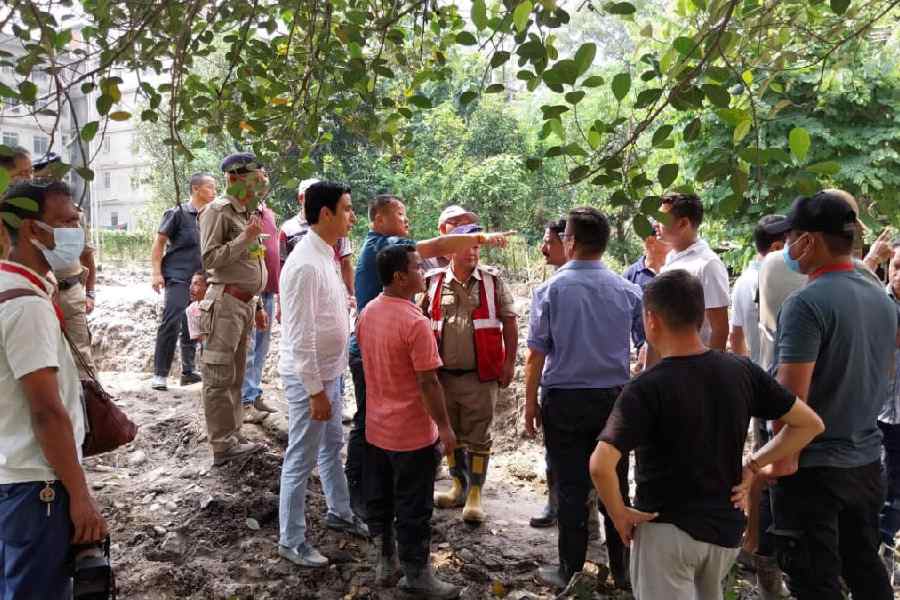The bamboo bridge swayed under their feet. Below, the merciless Teesta fumed and frothed against the rocks. But the team of doctors from Gangtok, unaccustomed to such perilous trips, soldiered on. They had a job to do.
The Teesta, which had washed away Sikkim’s largest dam within 10 minutes a few days earlier, was still furious when Benoy Upreti and his team of doctors reached Chungthang on October 8 with bagfuls of medicines.
Chungthang, a town of 10,000, had borne the brunt when an outburst of the South Lhonak Lake in north Sikkim swelled the Teesta and caused flash floods.
However, local people and army personnel had erected a bamboo bridge over the river by October 8, restoring connectivity to Chungthang four days after disaster struck on October 3-4 night.
“It was nerve-racking watching the raging and roaring Teesta beneath and knowing one had to cross the river on a bamboo bridge that was swinging wildly,” Dr Upreti, 38, told The Telegraph over the phone on Thursday.
“I guess we had a sudden adrenaline rush that pushed us across the bamboo bridge.”
Videos show the team of doctors precariously tiptoeing across the bridge over a seething Teesta, risking life and limb to bring succour to a population in distress. “We knew we had to reach the people in those far-flung areas that had been cut off,” Dr Upreti said.
Dr Upreti and his colleagues from Gangtok’s Central Referral Hospital Manipal — Dr Ronald Rai, Dr Sushila and Dr Caroline Karthak — had set off from Gangtok on October 7 with a forest official, Tshering Thendup Gensapa, as their guide.
They carried medicines worth Rs 70,000, having pooled the money themselves.
The Indian Medical Association and the Sikkim government facilitated the trip, they said.
The team halted at the district headquarters, Mangan, for the night and set off for Chungthang, about 94km from Gangtok, the following day.
“We had to trek more than an hour and then hitch a ride to reach the other side of Chungthang on Sunday (October 8),” Upreti said.
The hike had left their legs tired. But the resilience of the marooned they witnessed in the town lifted their spirits.
The previous day, local people had set up a zipline — a cable stretched between two points of different heights so that people can slide along it with the help of a suspended pulley.
“Local people, including Lachen Mangan MLA Samdup Lepcha, had ziplined over the river to reach Chungthang, which was completely cut off,” said Nirmal Mangar, a journalist from Sikkim who was among the first to reach the area from Gangtok.
“When the homemakers saw us, they could not control their tears. I had nothing much to offer; I felt so helpless,” he said.
“I admit that I too could not hold back my tears when I saw how their lives had been destroyed so suddenly.”
Fourteen people — mostly employees of the Teesta Stage III hydel project — who had risked their lives amid the rushing floodwaters to open the dam gates and shout warnings to local people are still missing.
Chungthang’s hardy hill people, however, are demonstrating the will to bounce back.
“The community seems close-knit. Initially, people seem to have stayed in relief camps (opened by local officials) but they are now slowly staying together (in homes),” Dr Upreti said.
“Four or five families moved into the homes of relatives that were safe. People are cooking food in common kitchens.”
With roads to places like Lachen, about 30km from Chungthang, completely washed away — and officials saying a rebuild might take over two months — people are using their traditional knowledge to construct bamboo bridges.
“Everyone is helping everyone in their own way in these trying times,” Upreti said.
Lachen and Lachung, both popular tourist destinations, are mostly dependent on tourism and agriculture. Tourists visiting the Yumthang Valley and the Gurudongmar Lake — which is at an altitude of about 17,000 feet — stay in these twin towns.
Tourism seems over for the season. Stranded tourists are still being evacuated following the construction of the bamboo bridge on October 8.
“Some 1,900 tourists were stuck in the area. There are still around 220-odd tourists left; we hope to rescue them by tomorrow (Friday),” a source in Chungthang said.
No one knows when tourism would return to north Sikkim. “We can only hope for better times,” a resident said.
The destruction has been widespread. A government centre set up to rear rabbits and a fisheries unit at Munshingthang have been wiped out. The road between Thangu and Lachen has vanished.
Tourists from Lachen are being flown out.
“We had the option to return by helicopter,” Upreti said, “but we thought we would be denying the tourists a chance to return. So, we decided to take the same land route back home.”
A second trip down the same bamboo bridge, and Upreti and his team were back in Gangtok on Wednesday evening.











